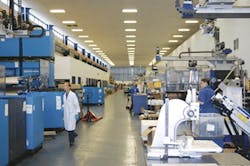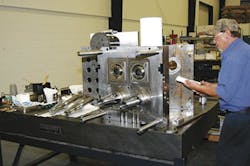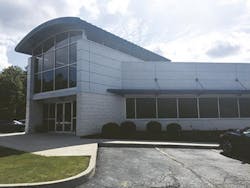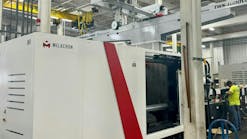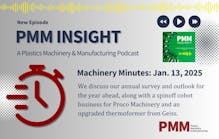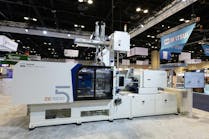Officials at custom injection molder Laszeray Technology have a challenge any processor would welcome. How does the North Royalton, Ohio, company accommodate double-digit growth in its 63,000-square-foot facility while maintaining production with its 24/5 shifts?
That is a challenge that officials there are happy to have. From finding a way to place a new 15-ton overhead crane to accommodating the arrival of a 1,000-ton injection molding press, they are getting comfortable with the juggling act.
"There is a lot happening, there are a lot of moving parts," said Michael Kalamasz, VP of operations, last month during an interview and plant tour with Plastics Machinery Magazine. "It's a lot of work, and hopefully we'll have some new assets in the next six months or so."
The near-future plan is to physically expand the plant to the northeast by about 25,000 square feet, which will involve digging up the parking lot. Based on some of the larger tonnage needs, the expansion might need to be even bigger, Kalamasz said. Officials are working with design-build specialists Campbell Construction Inc., Wooster, Ohio, and machinery and equipment suppliers, including Wittmann Battenfeld, which will supply the new injection molding presses and automation for the facility expansion.
STAYING ORGANIZED WHILE MANAGING ASSETS
To maintain the plant's competitive edge, officials must think about how the presses are being used and adhere to a robust preventive maintenance program that includes servicing molds after each run.
Seventeen existing Battenfeld injection molding presses are positioned at 90-degree angles with requisite materials-handling equipment and robotics. Kalamasz said the company tries to maintain at least 36 inches around its machines - more if there are clearance issues caused by features such as doors. Officials recently added the company's 18th press, a 1,000-ton Cincinnati Milacron that was transferred from another molder. The behemoth has three injection units and, depending on the job and mold size, weighs up to 150,000 pounds. A line in the floor illustrates where a concrete pad was added, doubling the concrete thickness.
"A lot of our equipment is less than 10 years old, and that is intentional as well," Kalamasz said. "It's managing the assets to know when technology is always changing — what assets do we need?"
There is more to the positioning of the presses than meets the eye. Where a lot of molders might squeeze in as many presses as possible, officials at Laszeray are focused on positioning them as sales tools.
"Respect the press," Kalamasz said. "That is our sexy piece of equipment. This is what does the work. So, we want to showcase it as a selling tool. They are well-maintained and they're truly oriented so that functionally, we can use them. You can see that in some cases we're using conveyors, in some cases we're using nothing at all, we're using hand pack. So, we want that flexibility, but we also want the accessibility to be able to come back [behind the machine] so we can operate where we need to operate. It's clean, we can do maintenance, we can upgrade. Even if you're just observing molds running, you've got a whole new avenue to watch them. It's really around accessibility and functionality of our presses."
The main production area is roughly 400 feet long with an aisle that typically is spaced at a minimum of 6 feet but extends to 10 feet with ease. Officials maintain spacing to allow for the forklift and other light-duty vehicles.
"We've left the presses very accessible for our maintenance teams and technicians," Kalamasz said. "There are certain benefits to leaving the presses in the orientations that we've placed them."
The facility also benefits from a drop ceiling, which allows it to hide the mechanical/electrical infrastructure, President and COO Ty Shirley said.
"Piping all over the facility, that can be an eyesore, right?" Shirley said. "We promote having a clean, organized work environment, and that obviously parlays right into your safety performance as an organization."
INSTALLING A 15-TON CRANE
While officials are planning for physical expansion, the existing building is undergoing its own changes. At the time of PMM's tour, workers were installing a 15-ton crane to help with the larger assets, including the molds that will be needed in the larger-tonnage machines.
"It gives us more versatility," Kalamasz said of adding the 15-ton crane to the 5-ton crane that is in place. "The PM [preventive maintenance] guys, because of the size of the molds, usually need to be able to use a crane. So, this gives us the ability for the PM guys to constantly use a crane, as well, and the mold technicians to be able to use the other one. It gives us more flexibility for quicker changeovers, etc."
The 5-ton crane is focused on one half of the facility and the 15-ton crane will be focused on the other half. Officials also had to ensure that the total load on the infrastructure did not exceed limits. The new crane, which is 10,000 pounds, and hoist, which is 4,000 pounds, had to be installed on a track that is 30-plus feet in the air with limitations imposed by existing infrastructure, such as the cinder block wall. Kalamasz said that the track's wheel base had to be designed to distribute the weight so that no one point had too much weight. That meant increasing the track's wheelbase from 10 feet to 15 feet to distribute that weight safely and appropriately.
The 5-ton crane was installed before the building's roof had been completed. Typically, workers would use a larger boom crane to install the 15-ton crane; however, the drop ceiling would not allow it.
Laszeray's rigger completed the installation with fork trucks and some ancillary equipment, Kalamasz said.
Angie DeRosa, managing editor
Contact:
Laszeray Technology LLC,North Royalton, Ohio, 440-582-8430, https://laszeray.com
